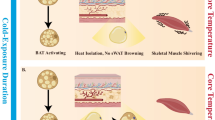Abstract
Obesity is a leading health problem facing the modern world; however, no effective therapy for this health issue has yet been developed. A promising research direction to identify novel therapies to prevent obesity has emerged from discoveries on development and function of brown/brite adipocytes in mammals. Importantly, there is evidence for the presence and function of active thermogenic brown adipocytes in both infants and adult humans. Several new investigations have shown that thermogenic adipocytes are beneficial to maintain glucose homeostasis, insulin sensitivity, and a healthy body fat content. Such thermogenic adipocytes have been considered as targets to develop a therapy for preventing obesity. This short review seeks to highlight recent findings on the development and function of brown/brite adipocytes in humans and to discuss potential treatments based on these adipocytes to reduce obesity and its related disorders.

Similar content being viewed by others
References
Atit R et al (2006) β-catenin activation is necessary and sufficient to specify the dorsal dermal fate in the mouse. Dev Biol 296(1):164–176
Cannon B, Nedergaard J (2004) Brown adipose tissue: function and physiological significance. Physiol Rev 84(1):277–359
Cantó C et al (2012) The NAD+ precursor nicotinamide riboside enhances oxidative metabolism and protects against high-fat diet-induced obesity. Cell Metab 15(6):838–847
Cunningham S et al (1985) The characterization and energetic potential of brown adipose tissue in man. Clin Sci 69(3):343–348
Cypess AM, et al. Activation of human brown adipose tissue by a β3-adrenergic receptor agonist. Cell Metab 21(1):33–38
Cypess AM et al (2009) Identification and importance of brown adipose tissue in adult humans. N Engl J Med 360(15):1509–1517
Cypess AM et al (2013) Anatomical localization, gene expression profiling and functional characterization of adult human neck brown fat. Nat Med 19(5):635–639
Fu T et al (2014) MicroRNA 34a inhibits beige and brown fat formation in obesity in part by suppressing adipocyte fibroblast growth factor 21 signaling and SIRT1 function. Mol Cell Biol 34(22):4130–4142
Harms M, Seale P (2013) Brown and beige fat: development, function and therapeutic potential. Nat Med 19(10):1252–1263
Houtkooper RH, Pirinen E, Auwerx J (2012) Sirtuins as regulators of metabolism and healthspan. Nat Rev Mol Cell Biol 13(4):225–238
Jespersen NZ et al (2013) A classical brown adipose tissue mRNA signature partly overlaps with brite in the supraclavicular region of adult humans. Cell Metab 17(5):798–805
Jukarainen S et al (2015) Obesity is associated with low NAD+/SIRT pathway expression in adipose tissue of BMI-discordant monozygotic twins. The Journal of Clinical Endocrinology & Metabolism 101(1):275–283
Khan NA et al (2014) Effective treatment of mitochondrial myopathy by nicotinamide riboside, a vitamin B3. EMBO Molecular Medicine 6(6):721–731
Lee P et al (2014) Irisin and FGF21 are cold-induced endocrine activators of brown fat function in humans. Cell Metab 19(2):302–309
Lidell ME et al (2013) Evidence for two types of brown adipose tissue in humans. Nat Med 19(5):631–634
Min SY et al (2016) Human ‘brite/beige’ adipocytes develop from capillary networks, and their implantation improves metabolic homeostasis in mice. Nat Med 22(3):312–318
Peirce V, Carobbio S, Vidal-Puig A (2014) The different shades of fat. Nature 510(7503):76–83
Petrovic N et al (2010) Chronic peroxisome proliferator-activated receptor γ (PPARγ) activation of epididymally derived white adipocyte cultures reveals a population of thermogenically competent, UCP1-containing adipocytes molecularly distinct from classic brown adipocytes. J Biol Chem 285(10):7153–7164
Saito M et al (2009) High incidence of metabolically active brown adipose tissue in healthy adult humans: effects of cold exposure and adiposity. Diabetes 58(7):1526–1531
Seale P et al (2008) PRDM16 controls a brown fat/skeletal muscle switch. Nature 454(7207):961–967
Shinoda K et al (2015) Genetic and functional characterization of clonally derived adult human brown adipocytes. Nat Med 21(4):389–394
Timmons JA et al (2007) Myogenic gene expression signature establishes that brown and white adipocytes originate from distinct cell lineages. Proc Natl Acad Sci 104(11):4401–4406
Traba J et al Fasting and refeeding differentially regulate NLRP3 inflammasome activation in human subjects. J Clin Invest 125(12):4592–4600
Trammell SAJ et al (2016) Nicotinamide riboside is uniquely and orally bioavailable in mice and humans. Nat Commun 7:12948
Trammell SAJ et al (2016) Nicotinamide riboside opposes type 2 diabetes and neuropathy in mice. Scientific Reports 6:26933
Van Marken Lichtenbelt WD et al (2009) Cold-activated brown adipose tissue in healthy men. N Engl J Med 360(15):1500–1508
Virtanen KA et al (2009) Functional brown adipose tissue in healthy adults. N Engl J Med 360(15):1518–1525
Wu J et al (2012) Beige adipocytes are a distinct type of thermogenic fat cell in mouse and human. Cell 150(2):366–376
Acknowledgments
We would like to thank Dr. Leslie P. Kozak (Maine Medical Center Research Institute, USA) for critical reading and helpful comments to improve this manuscript before submitting.
Dinh-Toi Chu is a current Marie Skłodowska-Curie postdoc under the Scientia Fellows programme cofunded by Faculty of Medicine, University of Oslo and the EU Seventh Framework Programme (FP7) under Marie S. Curie scheme—People: Cofunding of Regional, National and International Programmes (COFUND), grant agreement no. 609020.
Author information
Authors and Affiliations
Corresponding author
Rights and permissions
About this article
Cite this article
Chu, DT., Tao, Y. Human thermogenic adipocytes: a reflection on types of adipocyte, developmental origin, and potential application. J Physiol Biochem 73, 1–4 (2017). https://doi.org/10.1007/s13105-016-0536-y
Received:
Accepted:
Published:
Issue Date:
DOI: https://doi.org/10.1007/s13105-016-0536-y




